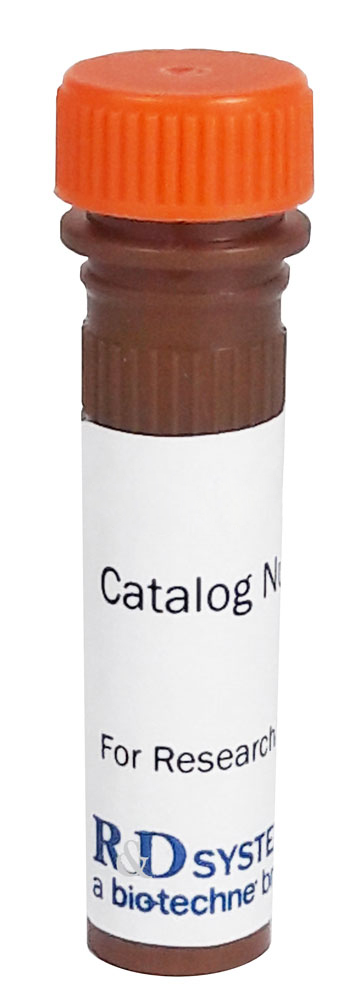Human/Mouse Frizzled-7 Alexa Fluor® 405-conjugated Antibody
Human/Mouse Frizzled-7 Alexa Fluor® 405-conjugated Antibody Summary
Gln33-Leu185
Accession # Q61090
Applications
Please Note: Optimal dilutions should be determined by each laboratory for each application. General Protocols are available in the Technical Information section on our website.
Reconstitution Calculator
Preparation and Storage
Background: Frizzled-7
Frizzled-7 is a member of the Frizzled family of unconventional G-protein-coupled glycoprotein receptors for the Wnt signaling pathway (1‑3). The Wnt genes encode a large family of glycoproteins that are essential in development and tissue maintenance (1, 2). Like other Frizzled family members, Frizzled-7 contains a divergent N‑terminal signal peptide (amino acid (aa) 1‑32), a highly conserved extracellular cysteine-rich domain (CRD, aa 44‑169), a variable-length linker region (aa 170‑256), a seven-pass transmembrane region (aa 257‑549), and a variable-length C-terminal cytoplasmic domain (aa 550‑574) (1‑3). The CRD, which comprises the binding site for Wnts and other ligands such as Syndecan 4 and fibronectin, spans about 130 amino acid residues and contains ten invariant cysteine residues (2, 3). Expressed alone, it can compete with native Frizzled to inhibit Wnt canonical signaling (4). Within aa 33‑185, human Frizzled-7 shares ~99% aa identity with human, rat, canine and bovine Frizzled-7. Mature Frizzled-7 also shares 80% aa identity with Frizzled-1 and Frizzled-2. Roles for Frizzled-7 have been determined in both canonical Wnt/ beta ‑Catenin-mediated signaling and non‑canonical planar cell polarity and calcium pathways (1, 2, 4). During development, Frizzled-7 is expressed during gastrulation and in the fetal gut, kidney and lung where it is thought to influence tissue morphogenesis via non-canonical signaling pathways (3‑5). In the adult, Frizzled-7 is expressed in skeletal muscle, especially in satellite cells that mediate muscle regeneration in response to Wnt-7a (3, 6). It is expressed in embryonic stem cells (ES), contributing to self-renewal signaling (7). It has been implicated in mesenchymal-to-epithelial transition in colorectal cancer (2, 8). Frizzled-7 mRNA has also been detected in adult heart and placenta (3).
- Schulte, G. and V. Bryja (2007) Trends Pharmacol. Sci. 28:518.
- Vincan, E. et al. (2007) Front. Biosci. 12:4558.
- Sagara, N. et al. (1998) Biochem. Biophys. Res. Commun. 252:117.
- Medina, A. et al. (2000) Mech. Dev. 92:227.
- Kemp, C.R. et al. (2007) Dev. Dyn. 236:2011.
- Le Grand, F. et al. (2009) Cell Stem Cell 4:535.
- Melchior, K. et al. (2008) Biol. Chem. 389:897.
- Vincan, E. et al. (2007) Oncogene 26:2340.
Product Datasheets
Product Specific Notices
This product is provided under an agreement between Life Technologies Corporation and R&D Systems, Inc, and the manufacture, use, sale or import of this product is subject to one or more US patents and corresponding non-US equivalents, owned by Life Technologies Corporation and its affiliates. The purchase of this product conveys to the buyer the non-transferable right to use the purchased amount of the product and components of the product only in research conducted by the buyer (whether the buyer is an academic or for-profit entity). The sale of this product is expressly conditioned on the buyer not using the product or its components (1) in manufacturing; (2) to provide a service, information, or data to an unaffiliated third party for payment; (3) for therapeutic, diagnostic or prophylactic purposes; (4) to resell, sell, or otherwise transfer this product or its components to any third party, or for any other commercial purpose. Life Technologies Corporation will not assert a claim against the buyer of the infringement of the above patents based on the manufacture, use or sale of a commercial product developed in research by the buyer in which this product or its components was employed, provided that neither this product nor any of its components was used in the manufacture of such product. For information on purchasing a license to this product for purposes other than research, contact Life Technologies Corporation, Cell Analysis Business Unit, Business Development, 29851 Willow Creek Road, Eugene, OR 97402, Tel: (541) 465-8300. Fax: (541) 335-0354.
FAQs
No product specific FAQs exist for this product, however you may
View all Antibody FAQsReviews for Human/Mouse Frizzled-7 Alexa Fluor® 405-conjugated Antibody
There are currently no reviews for this product. Be the first to review Human/Mouse Frizzled-7 Alexa Fluor® 405-conjugated Antibody and earn rewards!
Have you used Human/Mouse Frizzled-7 Alexa Fluor® 405-conjugated Antibody?
Submit a review and receive an Amazon gift card.
$25/€18/£15/$25CAN/¥75 Yuan/¥2500 Yen for a review with an image
$10/€7/£6/$10 CAD/¥70 Yuan/¥1110 Yen for a review without an image



